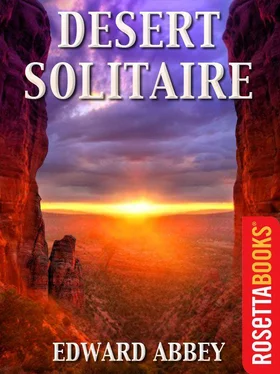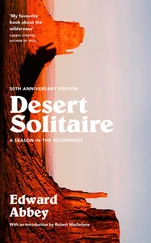Abbey, Edward - Desert Solitaire (Edward Abbey Series )
Здесь есть возможность читать онлайн «Abbey, Edward - Desert Solitaire (Edward Abbey Series )» — ознакомительный отрывок электронной книги совершенно бесплатно, а после прочтения отрывка купить полную версию. В некоторых случаях можно слушать аудио, скачать через торрент в формате fb2 и присутствует краткое содержание. Год выпуска: 2011, Издательство: RosettaBooks, Жанр: Старинная литература, на английском языке. Описание произведения, (предисловие) а так же отзывы посетителей доступны на портале библиотеки ЛибКат.
- Название:Desert Solitaire (Edward Abbey Series )
- Автор:
- Издательство:RosettaBooks
- Жанр:
- Год:2011
- ISBN:нет данных
- Рейтинг книги:4 / 5. Голосов: 1
-
Избранное:Добавить в избранное
- Отзывы:
-
Ваша оценка:
- 80
- 1
- 2
- 3
- 4
- 5
Desert Solitaire (Edward Abbey Series ): краткое содержание, описание и аннотация
Предлагаем к чтению аннотацию, описание, краткое содержание или предисловие (зависит от того, что написал сам автор книги «Desert Solitaire (Edward Abbey Series )»). Если вы не нашли необходимую информацию о книге — напишите в комментариях, мы постараемся отыскать её.
Desert Solitaire (Edward Abbey Series ) — читать онлайн ознакомительный отрывок
Ниже представлен текст книги, разбитый по страницам. Система сохранения места последней прочитанной страницы, позволяет с удобством читать онлайн бесплатно книгу «Desert Solitaire (Edward Abbey Series )», без необходимости каждый раз заново искать на чём Вы остановились. Поставьте закладку, и сможете в любой момент перейти на страницу, на которой закончили чтение.
Интервал:
Закладка:
Today, outside the canyon country and particularly in Arizona and New Mexico, the Indians are making a great numerical comeback, outbreeding the white man by a ratio of three to two. The population of the Navajo tribe to take the most startling example has increased from approximately 9500 in 1865 to about 90,000 a century later—a multiplication almost tenfold in only three generations. The increase is the indirect result of the white man’s medical science as introduced on the Navajo reservation, which greatly reduced the infant mortality rate and thereby made possible such formidable fecundity. This happened despite the fact that infant mortality rates among the Indians are still much higher than among the American population as a whole. Are the Navajos grateful? They are not. To be poor is bad enough; to be poor and multiplying is worse.
In the case of the Navajo the effects of uncontrolled population growth are vividly apparent. The population, though ten times greater than a century ago, must still exist on a reservation no bigger now than it was then. In a pastoral economy based on sheep, goats and horses the inevitable result, as any child could have foreseen, was severe overgrazing and the transformation of the range—poor enough to start with—from a semiarid grassland to an eroded waste of blowsand and nettles. In other words the land available to the Navajos not only failed to expand in proportion to their growing numbers; it has actually diminished in productive capacity.
In order to survive, more and more of the Navajos, or The People as they used to call themselves, are forced off the reservation and into rural slums along the major highways and into the urban slums of the white man’s towns which surround the reservation. Here we find them today doing the best they can as laborers, gas station attendants, motel maids and dependents of the public welfare system. They are the Negroes of the Southwest—red black men. Like their cousins in the big cities they turn for solace, quite naturally, to alcohol and drugs; the peyote cult in particular grows in popularity under the name of The Native American Church.
Unequipped to hold their own in the ferociously competitive world of White America, in which even the language is foreign to them, the Navajos sink ever deeper into the culture of poverty, exhibiting all of the usual and well-known symptoms: squalor, unemployment or irregular and ill-paid employment, broken families, disease, prostitution, crime, alcoholism, lack of education, too many children, apathy and demoralization, and various forms of mental illness, including evangelical Protestantism. Whether in the favelas of Rio de Janeiro, the barrios of Caracas, the ghettos of Newark, the mining towns of West Virginia or the tarpaper villages of Gallup, Flagstaff and Shiprock, it’s the same the world over—one big wretched family sequestered in sullen desperation, pawed over by social workers, kicked around by the cops and prayed over by the missionaries.
There are interesting differences, of course, both in kind and degree between the plight of the Navajo Indians and that of their brothers-in-poverty around the world. For one thing the Navajos have the B.I.A. looking after them—the Bureau of Indian Affairs. The B.I.A. like everything else is a mixture of good and bad, with policies that change and budgets that fluctuate with every power shift in Washington, but its general aim over the long run has been to change Indians into white men, a process called “assimilation.” In pursuit of this end the little Indians are herded into schools on and off the reservation where, under the tutelage of teachers recruited by the B.I.A. from Negro colleges deep in the Bible Belt, the Navajo children learn to speak American with a Southern accent. The B.I.A., together with medical missions set up by various churches, also supplies the Navajos with basic medical services, inadequate by national standards but sufficient nevertheless to encourage the extravagant population growth which is the chief cause, though not the only cause, of the Navajos’ troubles.
A second important difference in the situation of the Navajo Indians from that of others sunk in poverty is that the Navajos still have a home of their own—the reservation, collective property of the tribe as a whole. The land is worn out, barren, eroded, hopelessly unsuited to support a heavy human population but even so, however poor in economic terms, it provides the Navajo people with a firm base on earth, the possibility of a better future and for the individual Navajo in exile a place where, when he has to go back there, they have to take him in. Where they would not think of doing otherwise.
Poor as the land is it still attracts the avarice of certain whites in neighboring areas who can see in it the opportunity for profit if only the present occupants are removed. Since the land belongs to the tribe no individual within the tribe is legally empowered to sell any portion of it. Periodic attempts are made, therefore, by false friends of the Navajos, to have the reservation broken up under the guise of granting the Indians “property rights” so that they will be “free” to sell their only tangible possession—the land—to outsiders. So far the tribe has been wise enough to resist this pressure and so long as it continues to do so The People will never be completely separated from their homeland.
Retaining ownership of their land, the Navajos have been able to take maximum advantage through their fairly coherent and democratic tribal organization of the modest mineral resources which have been found within the reservation. The royalties from the sale of oil, uranium, coal and natural gas, while hardly enough to relieve the Indians’ general poverty, have enabled them to develop a tribal timber business, to provide a few college scholarships for the brainiest (not necessarily the best) of their young people, to build community centers and finance an annual tribal fair (a source of much enjoyment to The People), and to drill a useful number of water wells for the benefit of the old sheep and goat raising families still hanging on in the backlands.
The money is also used to support the small middle class of officials and functionaries which tribal organization has created, and to pay the costs of a tribal police force complete with uniforms, guns, patrol cars and two-way radios. These unnecessary evils reflect the influence of the Bureau of Indian Affairs and the desire on the part of the more ambitious Navajos to imitate as closely as they can the pattern of the white man’s culture which surrounds them, a typical and understandable reaction. Despite such minor failures the Navajos as a tribe have made good use of what little monetary income they have. It is not entirely their fault if the need remains far greater than tribal resources can satisfy.
Meanwhile the tribal population continues to grow in geometric progression: 2… 4… 8… 16… 32… 64, etc., onward and upward, as the majority of The People settle more deeply into the second-class way of life, American style, to which they are fairly accustomed, with all of its advantages and disadvantages: the visiting caseworker from the welfare department, the relief check, the derelict automobiles upside down on the front yard, the tarpaper shack next to the hogan and ramada, the repossessed TV set, the confused adolescents, and the wine bottles in the kitchen midden.
Various solutions are proposed: industrialization; tourism; massive federal aid; better education for the Navajo children; relocation; birth control; child subsidies; guaranteed annual income; four lane highways; moral rearmament. None of these proposals are entirely devoid of merit and at least one of them—birth control—is obviously essential though not in itself sufficient if poverty is to be alleviated among the Navajo Indians. As for the remainder, they are simply the usual banal, unimaginative if well-intentioned proposals made everywhere, over and over again, in reply to the demand for a solution to the national and international miseries of mankind. As such they fail to take into account what is unique and valuable in the Navajo’s traditional way of life and ignore altogether the possibility that the Navajo may have as much to teach the white man as the white man has to teach the Navajo.
Читать дальшеИнтервал:
Закладка:
Похожие книги на «Desert Solitaire (Edward Abbey Series )»
Представляем Вашему вниманию похожие книги на «Desert Solitaire (Edward Abbey Series )» списком для выбора. Мы отобрали схожую по названию и смыслу литературу в надежде предоставить читателям больше вариантов отыскать новые, интересные, ещё непрочитанные произведения.
Обсуждение, отзывы о книге «Desert Solitaire (Edward Abbey Series )» и просто собственные мнения читателей. Оставьте ваши комментарии, напишите, что Вы думаете о произведении, его смысле или главных героях. Укажите что конкретно понравилось, а что нет, и почему Вы так считаете.












